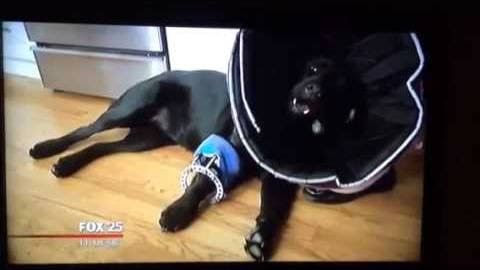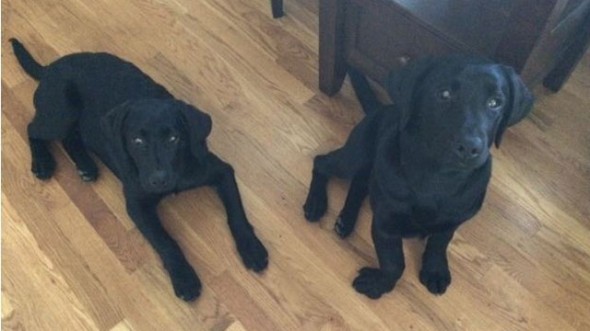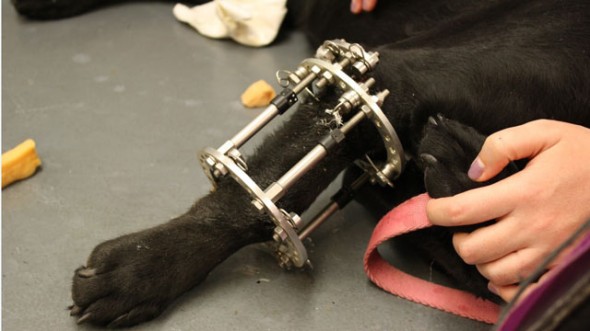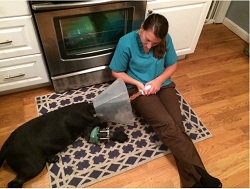.
Angell Animal Hospital Doctors “Grow” Bone for Dog with Crippling Leg Condition
A friendly disposition and a cute, crooked front paw immediately drew Jessica Cantone and her fiancé Nick to the weeks-old black lab puppy they named “Lucy” and brought home—along with her lookalike sister—earlier this year. Little did they know that Lucy’s outward-facing paw was actually a deformity that would affect her quality of life for months to come, and require surgery at the MSPCA’s Angell Animal Medical Center in Boston, Massachusetts to correct.
Painful puppy play
Lucy and her sister, named “Lola,” immediately settled into their new owners’ Boston-area home. The dogs’ early days were marked by constant play and walks around the neighborhood. Soon after, though, Jessica noticed a change. “At first it was subtle—Lucy would stop playing and sit down even as Lola continued to encourage her on. Shortly thereafter she began to limp immediately after playing.”
Jessica brought Lucy to her local veterinarian who examined the dog’s right front paw and reassured Jessica that, despite the deformity, Lucy would be able to compensate as she got older. The limping got worse, however, and Lucy was referred to Angell.
Lucy’s trip to Angell
Determined to help Lucy overcome her physical limitations, Jessica brought her to see Drs. Sue Casale and Daniel Frem of Angell’s renowned surgery service. “Lucy had a right radius (ulna) angular limb deformity—which means the bones of her legs were misshapen—causing her paw to turn out and, as a result, compromising the leg’s ability to bear weight,” said Dr. Casale. Moreover, the affected leg was nearly one inch shorter than her other front leg. “This is what was causing her so much pain.”
Drs. Casale and Frem employed a novel procedure called a corrective osteotomy in which Lucy’s lower leg bone was cut and re-aligned using a device called a “circular external fixator,” which was attached to the outside of her leg.
Growing new bone
The fixator kept the two ends of the bone aligned to encourage a natural process called “osteogensis,” in which the two ends of the bone—despite being completely separated—began to grow toward one another.
Jessica and Nick played an active role in helping the new bone to grow. “For nearly a month we turned three knobs, three times per day, with a wrench to keep pace with the growing bone—it was fantastic to know that we were literally helping her grow new bone tissue.”
The couple devised novel ways to help Lucy overcome the discomfort associated with the adjustments by, for instance, adjusting the fixator when she was eating her favorite food.
Lucy’s Road Ahead
After three weeks of adjustments the leg had “grown” almost an inch, making in equal in length to Lucy’s other front leg. Lucy is expected to wear the fixator for another six weeks or so, while the new bone tissue settles and heals. After that, it is on to physical therapy to rebuild her leg muscles.
After the emotional and physical roller coaster that defined Lucy’s journey, the couple is thrilled to have their dog home and on the mend—even with the physical therapy still ahead of them. “She is so happy to be home,” said Jessica. “I know she’ll go on to have many years to enjoy hiking, running, walks in the park and all the other activities that have been so hard for her in the past.”
Lucy had surgery about two months ago and, after a visit to Angell Medical Center last week, he vets were pleased with the results as her bones have fused.
Lucy is expected to have to wear her fixator for a few more weeks, but then it can come off and she will be able to walk and play like a normal dog.
Lucy’s story was featured in a local news report:
.
.
.
.
.
<via>




